Okay, so it's time to raise your rates, but how? Welcome to Episode 6 of the season! It's the logical follow-up to last week's episode sharing 11 signs that you need to charge more. So now that you're clear you need to charge more, here are 7 ways to make it happen without feeling icky about it.
Share your thoughts and ideas in the comments. Your insights may spark a conversation that helps someone else!
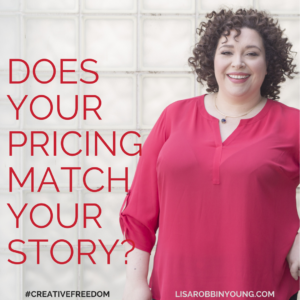
Mentioned in this episode:
If you haven't already downloaded this week's bonus content, you'll want to do that here. Not a member yet? It's free! When you register for email updates, you also get access to episode transcripts, worksheets, and other downloadables!
Fashion jewelry from Kerianne at FancyBargain.com. Tell her you saw her bling on Creative Freedom!
Music: "Welcome to the Show" by Kevin MacLeod
Licensed under Creative Commons: By Attribution 3.0
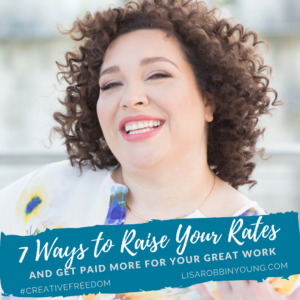 This is Season Four, Episode Six. This is the next logical step after our last episode. Once you get clear that it's time to raise your rates, how, exactly do you go about raising them? Have a listen to this week's episode, where I walk you through a few different approaches, from the basic, Nike approach (just DO it already!) to the "Tuna Can" approach and more. This is the fifth episode in a series about overcoming underearning.
This is Season Four, Episode Six. This is the next logical step after our last episode. Once you get clear that it's time to raise your rates, how, exactly do you go about raising them? Have a listen to this week's episode, where I walk you through a few different approaches, from the basic, Nike approach (just DO it already!) to the "Tuna Can" approach and more. This is the fifth episode in a series about overcoming underearning.
Speaking of which, my program Overcoming Underearning for Creative Entrepreneurs is now open. If you need support in owning the value you bring to the marketplace, and adjusting your prices accordingly join us! Students are already reporting positive results!
Download Season 4 Episode 6 | iTunes | Anchor | Stitcher
If you’re listening to just the podcast, you’re only getting about a third of the deal. Catch the Creative Freedom web series or join me on Facebook on Fridays at 5:30pm Central time for a LIVE Q&A about the week's topic.
4:22 - Several options to raise rates with existing clients
10:23 - 2 of the 4 big questions every offer needs to answer (and why it matters to your pricing)
14:26 - How one coach cut her content in half and doubled her rates, effectively quadrupling her hourly rate.
21:26 - DIY, DWY, DFY - and how I use these tiers in my own business
Not a member yet? It's free! Click here to join our Rising Tide to get email updates, transcripts, and bonus downloadables only available to members.
Mentioned in this episode:
Music: "Welcome to the Show" by Kevin MacLeod
Licensed under Creative Commons: By Attribution 3.0
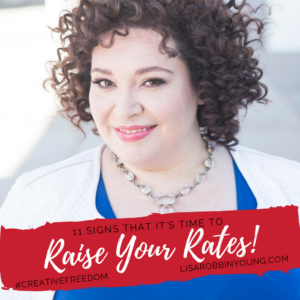 This is Season Four, Episode Five. This one's all about the dolla billz, baby! Whether you've raised your prices in the last year or the last month, it could be time to raise them again if they didn't go high enough in the first place. Many creative entrepreneurs get emotional when it comes to price increases. So, what if there were an easy, external way to know that it's time to raise your rates?
This is Season Four, Episode Five. This one's all about the dolla billz, baby! Whether you've raised your prices in the last year or the last month, it could be time to raise them again if they didn't go high enough in the first place. Many creative entrepreneurs get emotional when it comes to price increases. So, what if there were an easy, external way to know that it's time to raise your rates?
Your wish is my command! Here are 11 external indicators that can help you determine if a price increase is right for your creative business. Need help communicating that price increase? Consider joining us for the Creative Freedom Guide To Overcoming Underearning, and build your confidence in changing your pricing!
Download Season 4 Episode 5 | iTunes | Anchor | Stitcher
If you’re listening to just the podcast, you’re only getting about a third of the deal. Catch the Creative Freedom web series or join me on Facebook on Fridays at 5:30pm Central time for a LIVE Q&A about the week's topic.
02:21 - Why working for free is problematic, and why you might be inadvertently "programming" people to ask you to work for free.
06:31 - How a client in an economically depressed community managed to raise his rates.
11:00 - When someone is playing "Moneyball" with you, it is time to raise your rates!
16:30 - The "tuna can" tactic that helps you raise rates without changing your current pricing.
19:07 - How to look at barter/trade differently.
22:00 - The power of a $25k offer.
Click here to join our Rising Tide to get email updates, transcripts, and bonus downloadables only available to members.
Mentioned in this episode:
Music: "Welcome to the Show" by Kevin MacLeod
Licensed under Creative Commons: By Attribution 3.0
Confession time: I have sort of a business crush on Mr. Franklin. I stumbled across his first book, Produced by Faith, just as I was finishing work on my own book, The Secret Watch. His collaborator, Tim Vandehey was a friend of my editor, and I was actually checking out Tim's work when I came across DeVon. I read his book, and immediately fell in love with his vision for spiritual success in a secular world - that comes from staying true to yourself (and how God designed you).
I also saw how he and I were up to the same thing in the entertainment world, but coming at it from opposite ends of the spectrum. And yes, I secretly hoped he would read my book and decide to make it into a movie, but I digress.
DeVon is inside the industry, making decisions, policies, and flipping the script on how business gets done in Hollywood. I'm on the outside, working with the very people that haven't had a chance because of the way the old regime operated - to learn how to "pick themselves" instead of waiting for some big break. We're both working to change the face of entertainment media for the better, so it's only natural that I was a big fan from the start. Where DeVon's first book focuses on the inner journey of the movie that is your life, The Hollywood Commandments is the next installment - how to be yourself inside a machine that may try to make you anything but.
Franklin is a devout Christian, but don't let that dissuade you from reading this book. It is filled with gold when it comes to navigating the rough waters of career success - whether you're in Hollywood, CA or Hollywood, AL (population 1000), whether you're in entertainment or animal training. It's not what you do, or where you do it that matters, it's who you are as you're doing it.
Franklin's book centers on ten "commandments" for staying true to yourself (and your faith) in a secular world. He serves up a lot of common knowledge concepts - like over promise and under deliver - so in that respect, it will feel as familiar as many self-help books on the market. But, as Franklin points out in Commandment #8, Your Difference Is Your Destiny. Franklin's difference is his years behind-the-scenes rising through the ranks in Hollywood, making mistakes, learning as he goes, and doing it all as a person of color and a man of faith to boot.
While Franklin never makes race a point in the book, it shouldn't be ignored. It's tough to rise up in Hollywood, and there's still a lot of disadvantages for a person of color. To see this, his third book, speak so plainly about what it really takes to succeed in anything (and have it come from a place of hard-won experience), speaks highly of his work ethic and how true Franklin is to walking his talk. He came to Hollywood on a Divine prompting, knowing no one, and trusting the process. He went from intern to assistant to eventually owning his own production company, paying his dues along the way. This is the lesson of persistence and discipline that Franklin espouses throughout the book.
Watch the entire review, where we'll dig into the specifics of the commandments, and how they apply to you regardless of your faith walk. Here's the replay:
This week I had an AMAZING photo shoot that's been several months in the making. I knew when I landed in Nashville, starting over would take up a good portion of my first year here. I also knew that I had projects that still needed to move forward: I've been sitting on Creative Freedom for a while now, and The Damn Whippersnappers have promised to visit this summer for a recording session. So with a new book and new music in the works, of COURSE I needed to get the website redone.
Only, I didn't know anyone in this town, so I had no idea how long I'd have to wait, how much it would cost, or anything. Luckily, my best friend, Google helped me out. I met Emily, a wardrobe stylist from Effortlesstyle here in Nashville. She came over, looked at my closet and said "let's just start from scratch, okay?"
hee. hee.

While I know how to clean up, I've never been at the bleeding edge of style, and I told her that. My closet is full of black, black, and more black - with a splash of solid color here and there. So I gave her a budget and she went to work. A week or so later, we met for the fitting. There was really only one piece I couldn't bring myself to like. Everything else was wonderful - and a lot of it I wouldn't have picked for myself. Like this floral top. When I first looked at it, all the voices in my head took a swing at me:
"Oh, you're too big to wear white!"
"That floral print is just going to draw all kinds of attention that you don't want."
I swallowed hard when she showed it too me. I knew Emily could sense my reluctance. "Just try it on." she politely insisted.
I did. We found a keeper.
I had just raised my threshold of belief around what was possible for my wardrobe. Emily's a professional that's been doing this for years. Despite that, it was hard to trust her at first because I didn't know her. I didn't believe she could style a plus-sized momma like me.
Luckily, she made it easy to like her, and her ensemble choices were on point, so trust came quickly.
Which was good, because the hair and makeup artist I had originally asked to do the shoot booked herself another appointment and was unable to make our shoot date. It wasn't her fault. I was trying to coordinate all the details myself, and things didn't come together. Frantic, I asked Emily if she had any suggestions.
Panic turned to relief, but I had no idea how much I'd be paying for TWO people instead of one.
I swallowed hard again, and just trusted the process.
I arrive at Emily's house on the day of the shoot for hair and makeup. Mind you, two total strangers are about to have their way with my head. The ONLY thing keeping me from not showing up is the commitment I made to my photographer, Ashley.
That, and I trusted Emily. She hadn't steered me wrong yet, so I figured she wasn't going to start now.
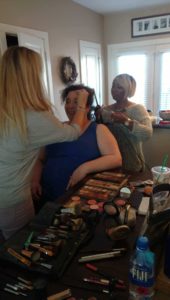
I knock on the door, walk in, and I'm greeted by two of the sunniest, most enthusiastic women I've ever met. Both hard-working artists, both incredibly talented. Both eager to make magic happen.
Why did I ever doubt Emily?
Within minutes they are both working on me: Angela at the front, Genia at the back. We're chatting, really connecting, and they're making it easy for me to trust them. But...
I don't even know how much time has gone by, I can't see a mirror, and I'm still too nervous to eat any of the snacks Emily's put out for us. I did manage to down a glass of water, because I kept telling myself "it's gonna be hot outside, you don't want to die of heat stroke!"
Still, I think I managed to keep my self-doubt to myself as we talked about building a business doing what you love, something I'm pretty passionate about. My fear was, hopefully, masked by my enthusiasm for profitable creative businesses.

When they finished, I snapped a quick photo of my glam team and off we went to meet Ashley at Cumberland Park. When I got in my car, I had all I could do to keep from crying. I looked GOOD! Like, I almost didn't recognize myself. I had a vision of what I wanted for the shoot, and even hired Duane "The Hair Fairy" Edlao to cut my hair before I met these ladies to make sure that it would do what we wanted it to do. But to see it actually come to life?
Whoa.
We headed off toward Nissan Stadium to meet Ashley for the shoot. This is the first time we've met in person, and she looks happy, so I'm feeling more relaxed at this point. She's got some ideas about how to get in all the wardrobe changes and make the most of our time together.
The first few pictures felt awkward to me - because my inner critic was having her way.

There was a couple sitting at a picnic table across the way. They both stopped and looked up as my entourage pulled up with all our gear. I joked about being famous, but inside I was a self-conscious mess.
Despite these women all being super talented professionals, my inner critic was having her way with me. I told Ashley to "just shoot everything" because I knew that candid moments would probably end up making the most "natural" shots, plus we'd get some behind-the-scenes shots, too, which would be great for me to share with my clients in A-club. In truth, I was just hoping that, if she shot everything, there might be something that I could use.
Good thing Emily was listening, because she took some great candids, too. Like the shot of Angela, above, touching up my face, or this one, which is quickly becoming one of my favorites.
When I saw the first photo, I knew I was in good hands and I could relax. That's when we had REAL fun!
We joked, got silly, and just enjoyed being together - creatives whose only agenda was to create. Make magic happen. That was all we had to do, and when we could really let loose and trust each other, poof! The magic was there naturally.
The rest of the hour-long shoot went by fast, and it really felt like we were a team - working together to tell a compelling visual story. I look forward to seeing the proofs that Ashley took. Here's a sneak peek from the back of Ashley's camera...
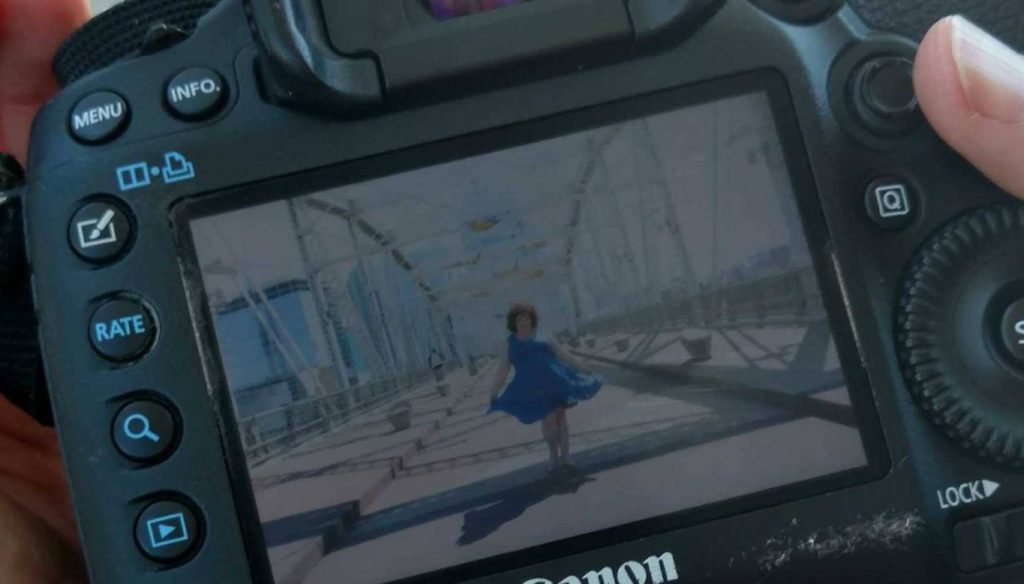
This photo shoot was a massive investment in the future of my company, and it would be easy to just stop there...
...But that would be the least important part of the story.
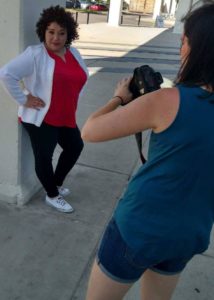
As the pictures started appearing, people on Facebook started asking me what the shoot was for. It was easy to say "new book, new album, new website," but that wasn't entirely true. It was also a "new me" of sorts.
In the past, I would have tried to DIY as much as possible and keep everything on the cheap - not to be efficient or save money (though those are the excuses I would have used), but because of my own self-worth.
I put at least ten times the money into this shoot than any other shoot I've ever done. I'm not saying that to brag. I still feel strange about it, to be honest. I tell you this because there was a time in my life where I didn't believe I was WORTHY of investing "that kind of money" in me or my dreams.
Some days, I still struggle with my worthiness.
My early photo shoots were courtesy of my kid, or good friends who were skilled with a camera. I actually hired a photographer and hair/makeup artist for my last shoot because I wanted to get some specific shots for the album. I was leery then about spending "that kind of money" on a project that had no guarantee of completion, let alone success. But I was so happy with the results that I used those pictures all over the interwebs for a couple of years.

This time, I had a team of three incredible women who had my back the entire time (four, counting my photographer!). They probably had no idea of the "who do you think you are?" trash talk my inner critic was laying on me. At least, I hope they didn't. I am thrilled that they made it SO easy for me to just be ME in front of the camera.
The next day, I was talking with one of my coaches about my book, online course, and live event all built around the foundation of Creative Freedom. One of the last things she said to me was about the pricing for my upcoming event. I've been in a holding pattern for WEEEEEEKS because I haven't been able to decide how to price it or how and when to offer the online version. I told her I feel confident that I could easily charge twice the price because I believe it'll bring a solid 5-10x return on investment, but I was keeping the intro rate low because I wanted to fill the program (totally an ego thing, by the way).
When she looked at my pricing and asked about my motivations, she reminded me that sometimes, when we offer discounts and low-ball our pricing, it doesn't actually empower our clients, because we're modeling a behavior that comes from a place of scarcity instead of abundance. She then asked me "what if, by lowering your prices, you're denying your clients from having the same experience you just had at your photo shoot?"
Eyes Opened.
If you've got a healthy relationship with money, this probably doesn't apply to you, but if you struggle with naming a price that feels right to you because your inner critic is asking "who will pay that?" - this could be helpful.
The answer to the "who will pay that?" question isn't found in the circle of people you've been begging to buy from you. The answer is found in the faces of the people who light up when you enter the room and say "where have you been all my life!?!?"
Sadly, most of us build our careers around the former and not the latter.
This is one of the reasons I encourage my clients to develop a $25,000 offer... not because anyone will ever buy it (though it does happen), but because it gets you thinking differently, so that when you offer something for $2k or $5k, you'll feel more confident around the real value you bring to your work.
What could happen (for you and your potential clients) if you just created and asked for the price you want without all the baggage attached?
Because it doesn't matter what price you pick, there will always be someone that can't or won't pay it. But there are also probably a few people who will.
Owning your dreams, without selling your soul. Finding yourself and building a life and business that works for who you really are and what really matters to you. Making good money doing what you LOVE (and all the ladies from my shoot love what they do). THAT is what Creative Freedom is about, and I can't wait to share more of this new evolution with you.
Oh, and tickets for the virtual workshop and online event will be on sale soon. If you're not already on my list, get there to be one of the first to know about it!
One of the scariest topics for most of my clients - the one that brings with it the most baggage and emotional upheaval - is pricing. Right now, about half of my Incubator clients are stalled out on the decision to raise their prices. As early-stage entrepreneurs, there's a struggle between wanting to earn more and not being convinced that they can/"should" raise rates, for fear that they can't get enough clients to pay them the higher rates when they've been struggling at a much lower rate for a while. What they don't realize is that those lower prices are appealing to the wrong kind of audience, and until they can clear their head trash, they'll stay stuck at the lower pricing.
Although I've used the phrase before, I don't believe you can really charge what you're worth. First of all, you're a priceless masterpiece. No one can define your worth. They can, however, decide how much their willing to pay for your Great Work. You can influence that decision, but ultimately, it rests with the buyer. So it's less about charging what you're worth and more about telling a compelling story so that potential buyers are willing to pay your asking price. As Tara Gentile says "Pricing tells a story". So what story does your pricing tell?
More often than not, pricing brings out a lot of hypocritical behavior. This week's episode explains how your inner hypocrite could be running your business into the ground.
Have you had moments in your business where you said one thing was important, but your actions revealed some other motivation? Have you experienced this "out of integrity" moment with other business owners? How did you handle it? Share your thoughts in the comments and be part of our Rising Tide.
Need support for your creative business? I have two openings in the Creative Freedom Incubator. Applications are accepted on a first-come, first served basis. If you're not ready for that level of hands-on help, join the growing community of supportive creatives in A-Club. We're here to help you grow.
I think it was my grandmother who first told me that you never get a second chance to make a first impression. I was going to her church for Easter Sunday, and, of course, I had to look my best. I was representing my family, I was showing up for God, and (probably most important to Grandma) her reputation was at stake.
It only made sense to put my best foot forward. I had to be well dressed, well groomed, AND well behaved. No pressure.
Then, maybe a year or two later, I heard it again, in a shampoo commercial.
So it's no wonder that those words strike fear into the hearts of many creative entrepreneurs when they attempt to bring their Great Work into the world (especially for the first time). One wrong move, one slip, and it's all down the tubes. Everything's over. Cash it in. We're done. Between that sentiment and the old saw about opportunity only knocking once, it feels like the stakes are incredibly high.
But are they really?
Do you really only get "one shot, one opportunity to seize everything you ever wanted, in one moment"?
Well, yes and no. Mostly no. Sir Richard Branson says that "opportunities are like buses; there's always another one coming." But there are things you can do to prepare yourself for the moments when opportunity comes a knock-knock-knockin' on your door. This week's episode explains.
Here's the "quick and dirty" summary from this week's episode:
Mike Michalowicz, a friend and author of the book Surge, explains that surfers can't ride every wave. They have to be able to get in front of it and be ready to stand up and ride. If the wave is too far away (or even too close up), they can't get in a good position to get up and ride. And if they chase every wave, they'd spend all day paddling and never get the chance to hang ten.
Waves are plentiful, so it's less about hitting every wave (or even finding the perfect wave), and more about being selective in the opportunities you take so that you can spend less time paddling and more time riding. Will you wipe out sometimes? Sure. But that's part of what keeps everyone from surfing: you have to be willing to wipe out a few times in order to catch the big wave.
What do you need to say "no" to, so that you can say "yes" to what really matters? Share your thoughts and ideas in the comments and be part of our Rising Tide.
If you need support, encouragement, and help bringing your vision to the world and preparing for your next opportunity, Accountability Club is now open for enrollment. Only a few seats remain, and I'd love to see you inside this community of doers. Our next training call is Feb 25!
How is it that one creative entrepreneur can have "instant success" while another puts in years of effort with little financial success to show for it?
If that's a question you've ever asked yourself, you're gonna LOVE this week's episode! I've talked at length before about the myth of the big break, and the myth of "overnight success". I'll probably talk more about it in the future, too. There are different definitions of success, however, so let me be clear. Today I'm talking about financial success.
You can put in way more than 10,000 hours toward your craft and still not be financially successful. Even if those hours are "deliberate practice," there are a series of steps every creative entrepreneur must go through in order to turn their craft into a well-paying career. There are lots of options at each of those steps, so what you choose will likely look different than anybody else, but the steps themselves are static. Meaning, you can't achieve financial success until you accomplish these three things. Let Peter Gabriel, Dale Chihuly, Danny DeVito, and Thomas Kinkade illustrate:
This is one of the most interesting take-aways from the work I'm doing for my upcoming book. Every creative entrepreneur that finds financial success goes through these three stages of business growth. Every single one of them. Some move quickly from one stage to the next, while others struggle for a while at one stage or another. But every one of the creatives I've interviewed or researched (again, I say, EVERY ONE OF THEM) went through these three stages to achieve the financial success they desired.
What's that thing that you do best? Not "better than everyone else," though that can help set you apart faster. More like "better than anyone else in your circle of influence." You're not looking for the thing that only you can do. If you have that, cool, but so many creatives get hung up on being completely unique. It's actually better and easier to find the thing you do really well - even if someone else does it, too. Because then you can put your twist on it and still give people a point of reference. The point of reference makes it easier for people to relate to you. Being completely unique requires a lot of extra time and energy to educate your potential audience. Being similar, but different, makes it easier for people to "get" you.
Plus, when you're similar, but different, it helps colleagues and collaborators work with you, refer to you, and spread the word about your awesomeness. You're no longer an army of one, trying to do it all yourself. Instead, you've got a growing network of people that know you, like, you, and trust you, that want to collaborate, rather than compete with you. Collaboration makes almost everything easier, because you can share the load... something most creatives have a hard time doing, but when they do it, the rewards are often exponential.
While it's fun to create for yourself, it's hard to make a living if you're not also creating for an audience. That doesn't mean selling your soul, being a "sell out", or taking on clients just because you need cash. Instead, it means interacting with your fans and followers, hearing their feedback, and responding to your audience in a way that works for you. It means cultivating relationships with people who appreciate the work you're already doing, want to see more of it in the world, and are willing to invest in your Great Work.
My first newsletter went out to 7 people, and I know at least one of those people is still on my list, some 10 years later. We've emailed, chatted on Facebook, and she's purchased from me a time or two. When she has something to say, I listen. I don't always agree, and I am still able to respect her thoughts and ideas. Sometimes I use them, sometimes I don't. I maintain creative control of my work, and I am not so arrogant as to think that my way is the only way.
Listening and responding to your audience isn't selling out, it's an act of courage that helps your business grow. (Tweet this!)
If I've learned anything working with clients in my Incubator program, it's that different creative entrepreneurs need different kinds of support. Some need very specific, detailed, step-by-step instructions, while others can do big things with a rough overview. One of my clients launched an online school (with two courses!) in less than a day, while another took weeks to build and implement a single marketing tactic. While the kind and amount of support you need may be different from the creative entrepreneur next door, you'll still need SOME kind of systems and support. Most of us need an email system. Most of us need some kind of time management and planning tools. You might need marketing support, or customer service support from salesforce admin, or social media support. The key here is to uncover what you really need and get it handled without over-systematizing.
Believe it or not, too many systems can be a bad thing, and yes, you can try to systematize too soon. I see it all the time. Systems and supports are meant to smooth things out. Yes, they can be bumpy at first, while you're ramping up, but if your systems and supports are slowing you down unnecessarily, then you've got too many - which can cause your business to struggle in an entirely different way.
It takes about a year of concerted effort to handle each of these. A year to hone your offer, a year to build your audience, and a year to get the right balance of systems and support. Can you shorten this time frame? Sure. Linears tend to over-systematize, Chaotics tend to be more focused on their offer, and Fusions tend to obsess over their audience (take the quiz to determine your type). If you can get out of your own head, or if you've got a team or a coach to turn to with expertise in these areas, you can shorten that window to as little as a year, maybe less. That also means a lot of hustle. Not everyone is cut out for that kind of hustle, and I don't generally recommend it, because of the number it can do on your health and well-being. But most creatives don't want to hear that it's going to be another three years before they're making good money doing what they love, so if you've got the bandwidth and the intestinal fortitude, go ahead and shrink that timeline. Just be sure you can manage it without burnout, or you'll end up in a start-stop cycle of feast and famine that could drag on for years (this girl speaks from experience, yo!).
What say you? Where are you at in this 3-year plan? Have you been bumping into walls for a while? What did you do to break through? Share your thoughts and ideas in the comments and be part of our Rising Tide!
Ready to get some support to grow your business? Enrollment for Accountability Club is now open, and we'd love to have you inside our hallowed halls!
Recently, a new subscriber reached out and asked me about uncovering her "Great Work" in the world.
First of all, I LOVE it when people email me their questions! If you've got a question, hit me up in the comments or send me an email.
But to answer her question, I had to look deeper at what she wrote. Turns out, she's one of those "Jack of all trades" kinds of people. You know the type: someone who makes you sick because they're really good at a lot of things... but they can't figure out what their ONE THING is in order to make a career at it.
Oh, I know this problem so intimately well... because I'm one of those people.
For years I worked with coach after coach who told me to pick one thing, focus in on one thing, and get good at one thing and let THAT become my income driver.
Problem: Getting good at something isn't an issue. I'm a quick study and can pick up a LOT of things quickly. Then, my learning addiction kicks in and compels me to go deep in the topic so I'm GOOD at it, too.
Yeah, it's kind of annoying to me also. hee hee.
Over the years, I've had so many jobs and career paths that I was starting to think something was wrong with me... but there's nothing wrong with me. In fact, I'm part of a rising number of people that I call "Fusion" Creatives.
With a rise in demand for Liberal Arts and General Studies type degree holders in the workplace, we're seeing a resurgence of "renaissance" types who are versed in a variety of topics, and can hold their own in multiple environments.
Like being at the nexus of creative entrepreneurship, for example.
As a musician and a business coach, I've been pressured for years by coaches and peers to hone in on one thing... but that's like asking me which of my kids gets to live in a sacrificial offering. Not gonna happen. I'd cut out my own heart first.
...but the world hasn't been ready to deal with us until recently. Books like Barbara Sher's "Refuse to Choose" have helped give credence to "Scanners" as she likes to call them. We're not flighty, we're actually incredibly valuable - even if we have a hard time seeing it ourselves.
This week's episode of Creative Freedom unveils a glimpse into this
Fusion types often think of themselves as not creative when compared to their Chaotic friends and colleagues. Chaotics are the type we most often think of as the "creative" people of the world. They can be artsy, or crafty, free-spirited, and willing to "go with the flow". Chaotics are also pretty good with people, communication, and have a strong connection to their definition of the Divine. Some people call them "right brained" but that's a misnomer that's been debunked in recent years.
So us Fusion types tend to feel a little "less than" when compared to our Chaotic colleagues.
Fusion types also find that they're the "creative ones" when compared to their Linear colleagues. Linears are the type that think more strategically, enjoy working with patterns, numbers, and figures, and often find themselves at a loss when it comes to building strong relationships, networking, or handling customer service issues. Some people call them "left brained" but - as you can guess - that's a misnomer, too.
And yes, Fusion types tend to feel a little intimidated (or overwhelmed) when comparing themselves to their more financially successful Linear colleagues.
But I said "potential" and potential not acted on is wasted. Fusion types can be good at just about ANYTHING. They just need to hone in and stay consistent, while having the courage to keep sharing their unique blend of Linear and Chaotic awesomeness. Chaotics marvel at Fusion's ability to stay on track, meet deadlines, and generally get stuff done (as a one-woman show, I might add). Linears appreciate the creative streak and courage Fusions have to be "on" with people.
In short, we're pretty freaking awesome, and we have a hard time seeing it because everyone around us is more Linear (or Chaotic) than we are. So instead of seeing our unique blend as fantastic, we worry if we'll measure up.
But when we DO finally stay consistent, we are the Creative Freedom type with the greatest capacity for financial and personal success.
Each type also has blind spots that slow down their trajectory. For Chaotics, it stars by having a choke hold on your creative vision. For Linears, it's being too focused on bottom-line results. For Fusions, it's perfectionism and comparisonitis that keeps us stuck.
When you learn your Creative Freedom type, you shine a light onto those hidden areas so that you can take action and see success more easily. I stumbled on all of this entirely by accident over years of working with clients and noticing the patterns they were demonstrating.
If I did my math applying the 10,000 hours concept correctly, it takes about 10 years of consistent effort to reach world class status. At 40, I should be world class at about 4 different things, if I applied myself properly over the years. That means, I've got another 30-40 years (or more) to master a few more things. Heck, even Tony Bennett has established himself as a painter as well as a singer!

Fusion creatives don't need to pick just one thing. YAY! Instead, we need to think of our talents like a rock band - like the Eagles: you've got a lead singer, and others singing backup. Everyone in that band sings at some point in the show - and they've all got years of practice at honing their craft. No one is ignored, and they all get to shine.
THAT is how a Fusion makes the most of their gifts and talents. Put one or two out front while the others provide "back up" and have the courage to experiment and rotate them out from time to time - just make sure you keep practicing and honing your craft before you make a big leap. You don't see the Eagles trying something new at their shows - that's what rehearsal's for.
Have you been the Jack of All Trades in your circle? How have you created a meaningful body of work with your skills and abilities? Did you take the quiz and learn your Creative Freedom type? If so, what is it? Share your thoughts and ideas in the comments and let's be a rising tide for everyone!
In my early days on Facebook, I was quick to follow anyone with a pulse. If they connected with me as a friend, I returned the favor. I watched my list of "friends" skyrocket to well over 1000 people in very short order.
Problem is, while my friend count was increasing, it didn't result in new friendships... just more nameless faces on my feed. I never had that problem on twitter, though. It moved so fast, I didn't WANT to follow a bunch of people that I couldn't keep up with.
The result? In my first full year of twitter activity, I generated an additional $30,000 in revenues that I could directly attribute to my time on twitter. I'd met tons of people, made great connections, and made inroads on my income goals as well.
And my follower count on Twitter was substantially lower than the thousands I had on Facebook.
That was a valuable lesson for me. Twitter was engaging and it helped me connect with real people in real time. I knew I couldn't keep up with thousands of Facebook friends that weren't really having conversations with me. I needed to cull my list of "Friends" down to the people I really connected with.
I was chasing a magic number. I thought that if I had thousands of facebook followers, it would result in thousands of dollars in income. That wasn't true for me. By chasing a number that didn't really matter to the bottom line of my business, I wasn't focused on results, I was focused on "looking good" - on vanity.
I knew I had to cull my list, but I didn't want my friend count to drop significantly in a single day. After all, I was still hooked on the vanity of having thousands of "friends".
But any number you're tracking that doesn't directly tie back to your bottom line results - numbers that just make you look good, or feel good, are vanity metrics.
Sure, vanity metrics can prop you up when you're feeling low, but over time, you start to resent them.
"Hey! I've got 10,000 friends! Why is no one seeing my posts? Why am I not making any money?"
Then you start to blame the platform, instead of addressing how chasing vanity metrics has compounded your problem.
"Stupid Facebook changed their algorithm, and now no one sees my stuff!"
Often, the problem isn't the platform, it's the way you're using it. If you've got 1000 "friends" that you never talk to, that you never interact with, why should Facebook's algorithm make your posts a priority for them?
...Not that I speak from experience or anything...(insert awkward silence and lots of blushing here)
So over time, I started doing something most people might consider unthinkable. Each day, when Facebook sends me the birthday announcements, I go into the profile of the birthday boy (or girl), and if I don't truly have a connection with them, and it's been more than a year since we've "friended" each other, I unfriend them.
"Happy Birthday! I just unfriended you!"
Now, I don't post it on their wall or make a big stink about it. I just deleted 2-3 people every day until I only had people in my friends list that I actually knew, had conversations with, or were people I wanted to spend time getting to know better.
In all the years I've been doing it, no one has ever grumped at me about unfriending them... which proves my point.
If you have no relationship with your connections, they won't miss you when you're gone. (Tweet this)
While looking at a high Klout score can inflate your ego, what really matters (at least for me) is the trend of that number. Is it going up, down, or staying the same? What does the trend mean for your business? If a rising Klout score means you're connecting with more people, and those people are your perfect-fit customers, then great! On the other hand, if it means you've just been more active on social media this month, then perhaps you need to re-think your business strategy.
Or maybe Klout means nothing to you (like it does for my colleague). What matters is that you're keeping track of the numbers that matter to you and your business in a way that works for you.
Here are a few numbers I track on a weekly basis (with the help of my AMAZING VA), to keep me on track in my business. In some cases, the number is important, while in other cases, it's the trend that matters most:
If I had to track all these (and more) myself, my creative brain would have a meltdown. Either that, or I'd spend more time getting lost in the sites as I collect the stats - which is why I have a VA (virtual assistant) handle most of this data collection for me. My financials (sales, income, expenses, etc.) are still handled on my end. Queen Latifah once said to make sure you are always the one who signs the checks, and I think that's sound advice.
The bottom line is that, in business, you need to be concerned with your bottom line. Depending on your Creative Entrepeneur type, it isn't always comfortable to do it. To be clear, making time to look at the metrics and money doesn't mean you're putting money ahead of people, either. As I've mentioned in previous posts, You've got to have profits, or you don't have a business... it's a charity or a hobby! There's nothing wrong with charities or hobbies, but you need to be clear which it is that you are running and behave accordingly.
What numbers have you been tracking that don't tie back to your results? What ways can you stop chasing vanity and start creating connections, engagement, and more meaning in the relationships with clients, subscribers and fans that you already have? Share your comments and become part of our Rising Tide.
Also, we're considering starting a free facebook group to take these concepts even deeper each week. Interested? Let me know! When there's enough interest, we'll make an announcement in my weekly newsletter. Not on the list? Use the handy dandy box at the top of the page and rectify that problem now. 🙂